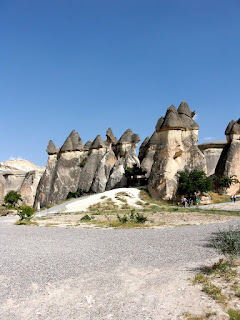


Before flying back to Istanbul on our last day in central Turkey, we left our host families and ventured into the surreal land of Cappadocia.
It contains several underground cities largely used by early Christians as hiding places before they became an accepted religion.
Wikipedia's description comes far from capturing the magic of this place, but at least it gives you a little history behind this awe-inspiring grandeur:
Cappadocia (pronounced /kæpəˈdoʊʃə/; also Capadocia; Turkish Kapadokya, from Greek: Καππαδοκία / Kappadokía) is a region in central Turkey, largely in Nevşehir Province.
The name was traditionally used in Christian sources throughout history and is still widely used as an international tourism concept to define a region of exceptional natural wonders, in particular characterized by fairy chimneys and a unique historical and cultural heritage. The term, as used in tourism, roughly corresponds to present-day Nevşehir Province.
In the time of Herodotus, the Cappadocians were reported as occupying the whole region from Mount Taurus to the vicinity of the Euxine (Black Sea). Cappadocia, in this sense, was bounded in the south by the chain of the Taurus Mountains that separate it from Cilicia, to the east by the upper Euphrates and the Armenian Highland, to the north by Pontus, and to the west by Lycaonia and eastern Galatia.
A few of us ventured into the vast catacombs that span 8 known floors beneath the surface. The ceilings and tunnels were so low in places that we had to reduce ourselves to hobbit stature in order to squeeze through the passages. Once back in the sunlight, we continued on to visit churches within other caves and the renowned fairy chimneys.
heyyy cappadocia travel gooodddd.
ReplyDeleteCappadocia Tours